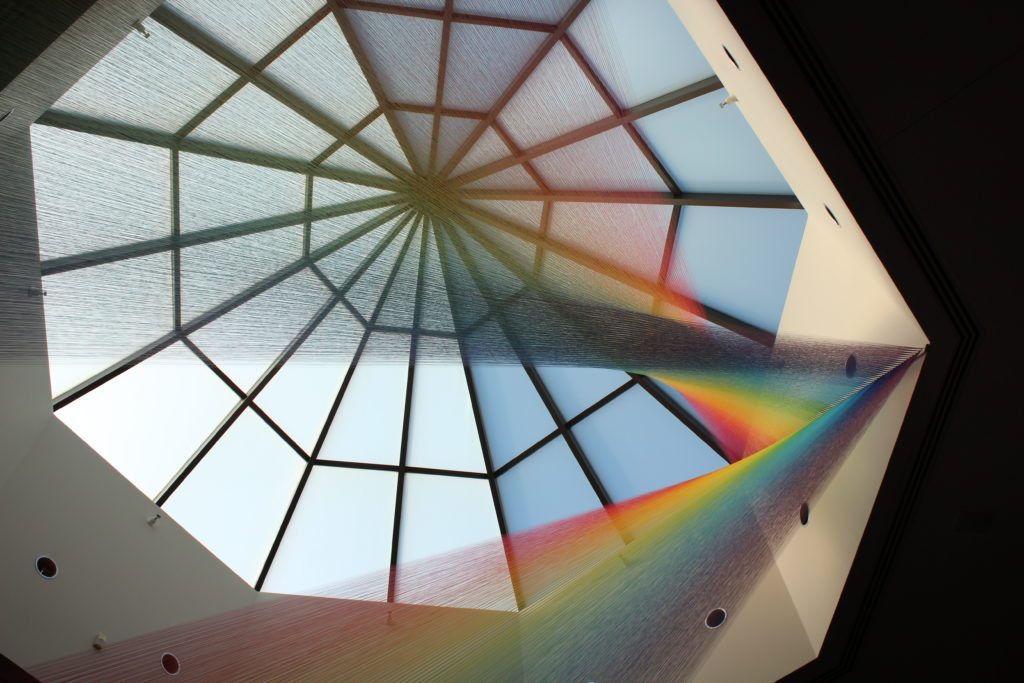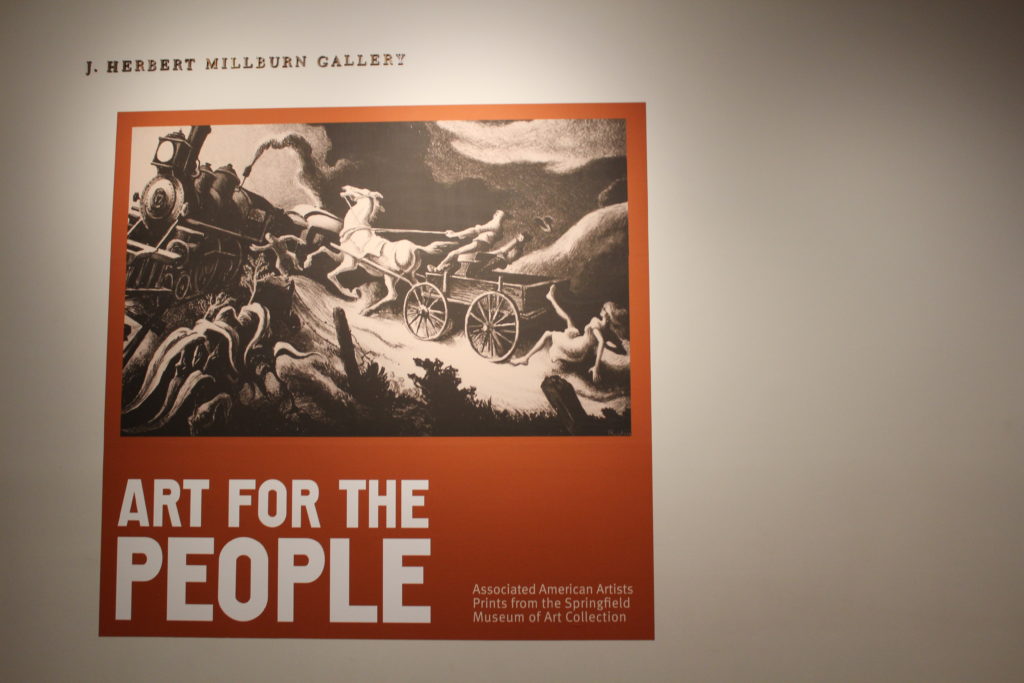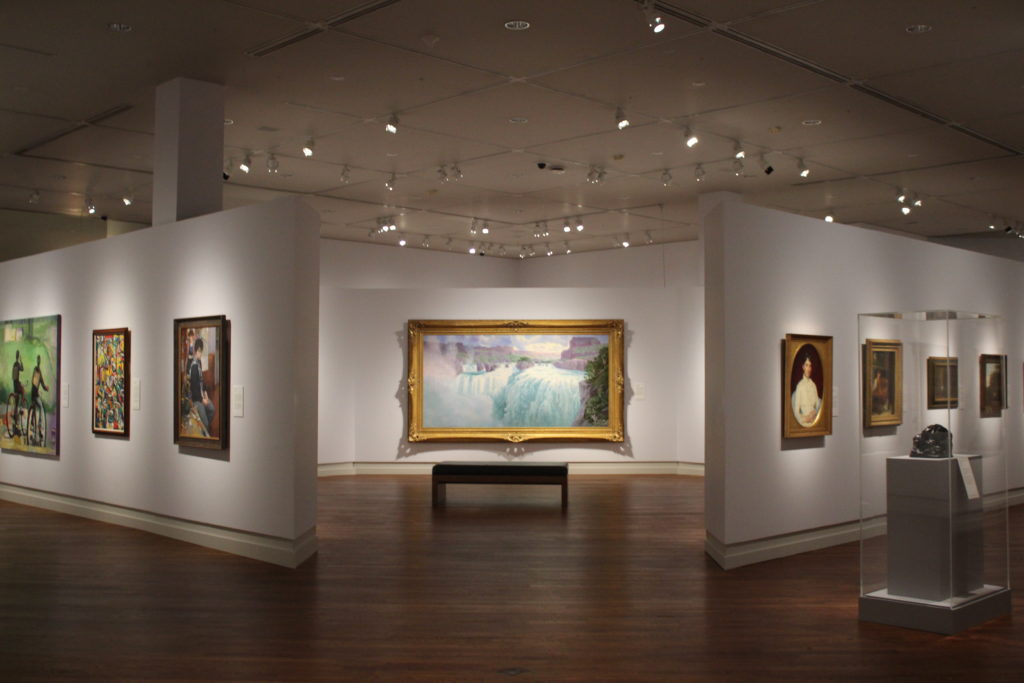See also: Paper conservation process is an art form at the Harold B. Lee Library

Museums can be filled with anything from ancient statues to modern sculptures. Some even display historical documents, colorful paintings and illuminated texts.
The BYU Museum of Art displays art through its semi-permanent and traveling exhibitions. Behind the art displays and interactive elements of exhibits are the museum staff — each member fulfilling unique responsibilities to aid in the acquisition and installation of art.

Gabriel Dawe (1973-Present), Plexus No. 29, 2014. (Photo taken by Rebecca Nissen) 
Carl Heinrich Bloch (1834-1890), Christ Healing the Sick at Bethesda, 1883, oil on canvas, 100 3/4 x 125 1/2 inches. Brigham Young University Museum of Art, purchased with funds provided by Jack R. and Mary Lois Wheatley, 2001. (Photo taken by Rebecca Nissen) 
Brigham Young University Museum of Art, Provo, UT, “Art for the People: Associated American Artist Prints from the Springfield Museum of Art Collection” Exhibition, 12/04/2020 – 4/21/2021. (Photo taken by Rebecca Nissen) 
Brigham Young University Museum of Art, Provo, Utah, “Treasures from the Collection” Exhibition, 8/17/2020 – Summer 2021. (Photo taken by Rebecca Nissen)
Acquiring art
Before art can be displayed at the MOA, it must first be acquired by the museum’s curators. Ashlee Whitaker, the Roy and Carol Christensen curator for religious art, has been in charge of curating a number of art pieces displayed at the museum. Whitaker’s curatorial responsibilities include searching for art to be added to the museum’s collection.
“We’re always looking for acquisitions and pieces of art that will enhance our collection and mission as a university art museum,” Whitaker said. She explained that art can be acquired by the museum in many ways, from art auctions to open galleries.
“We also have been really lucky where there may be someone who has already collected works of art and have had it in their private collection,” Whitaker said. “Which is, you know, like Christmas anytime that happens.”
One of those donations happened to be painted by Rembrandt Harmenszoon van Rijn — a Dutch painter famous for his portraits. His self-portrait is currently on display at the Metropolitan Museum of Art in New York City.
In a narrative written in 2016, Whitaker wrote that the artist of the painting titled “Head of Christ,” was unknown. Its previous owner had stored the painting under her bed for many years, not knowing what do with it. The owner’s wish to donate the painting to a museum was realized when a member of The Church of Jesus Christ of Latter-day Saints was helping her clean her estate and offered to call the MOA. The artwork was soon hand-delivered to the MOA.

“When the wrapped artwork was unveiled, exuding the style and technique of Rembrandt and with paperwork asserting it as ‘Head of Christ, Circle of Rembrandt,’ it was a transformative day for the museum’s collection,” Whitaker said.
She said the series of paintings of Christ completed between the years 1643 and 1655 likely could have been painted by Rembrandt’s students, as they “all seem to reflect the same model with similar features.”
Art like the “Head of Christ” isn’t always donated to the museum. Oftentimes, curators like Whitaker have to attend art auctions to acquire pieces to display at the MOA. In the recording below, Whitaker tells the story of how she acquired “The Blind Man at the Pool of Siloam” by Edmund Blair Leighton for the MOA:
The MOA doesn’t only display art from their own collection. Whitaker said that by reaching out to professional museum organizations, museum curator associations and independent curating groups, the MOA can display art that is on tour or that is on loan from another museum.
Whitaker said compiling art for an exhibit is like writing an essay. She will often come up with one theme or message and find artwork that supports that message.
“That’s how I look at the exhibits that we build,” Whitaker said. “We have an idea and then each work of art contributes something unique that feeds back into them.”
Installing art
After acquired art is restored by conservators and the art from other museums is delivered, the exhibit is installed. However, before the art can be installed, the exhibit layout and display must be created.
Anna Bates, exhibition designer for the MOA, is in charge of designing environments that best exhibit the art on display at the museum. Bates said although each process of designing an exhibition is different, a team is always assigned. According to Bates, each team usually consists of the following: a curator, educator, designer, fabricator and the registration team.
After the curator plans the theme and selects art pieces for the exhibition, they will go to exhibition designers like Bates. She said she then works “closely with the curator and the educator (to) distill those ideas and those messages down to the visual representation.”
“We want the design to make the art stand out,” Bates said. She explained that the design is never supposed to overshadow the art on display. However, there are occasional pieces of art that need a bigger “dramatic” display.
“We had a show — an exhibition. It was about Vishnu from Indian culture,” said Bates. “The design was over the top, and it was beautiful. And it made these artifacts that you might have passed by kind of shine and jump out in this colorful and beautiful dynamic space.”

In addition to creating space for artwork, Bates and other designers also often leave space where patrons can interact with and contribute to the exhibit. Bates gave an example of an area in the “Loving Devotion: Visions of Vishnu” exhibit where patrons could write messages on lotus-shaped flowers and place them on the wall.
“Our museum isn’t really a hands-on museum like a natural history museum might be or a science museum,” Bates said. “We ask patrons not to touch the art because it’s sensitive and delicate and often worth quite a bit of money. So, we try to add these elements that are interactive.”
After the exhibition designer and educator design the exhibit and the fabricator creates it, the registration team is then in charge of installing the art.
“The registration team (members) are the art handlers,” Bates said. “They handle all of the artwork coming in and out of the building and they keep (the art) safe. They are the only ones who are physically allowed to touch the art, hang it or move it.”
Tiffany Wixom, collections manager, said everyone who handles the art must receive proper training. “We always wear gloves whenever we’re handling artwork.”

Handling and hanging the artwork isn’t the only thing Wixom does when it arrives at the MOA. She is also in charge of knowing the location of all the museum’s artwork. This includes all loaned art on display at the museum. She tracks the art through an online database called The Museum System.
“Each object that comes into the collection is given a nine-digit number that we can use to track the work,” Wixom said. “It’s always on the artwork somewhere where no one else can see it — usually on the back of a frame, or if it’s work on paper, we write it on the back of the work. Or if it’s on statues, it’s usually on the bottom.”
Tracking, installing, designing and curating are a few of the responsibilities that museum employees shoulder to create exhibitions that convey their intended messages to the museum’s patrons, young and old.
Spirituality and art
The MOA has been hosting patrons since its opening in 1993. Although COVID-19 required the museum to shut its doors, it reopened to the public in August 2020. As one of a number of university museums in Utah, the MOA sets itself apart with its large collection of religious art.
“I think what makes us the most unique is our connection to the Church” and the museum’s emphasis on religious art and spirituality in art, said Janalee Emmer, associate director of exhibitions and programming.
Current exhibitions at the BYU Museum of Art can be found here.




